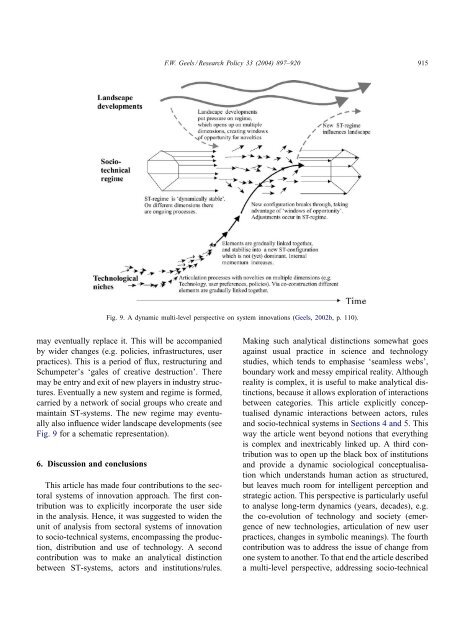From sectoral systems of innovation to socio-technical systems ...
From sectoral systems of innovation to socio-technical systems ...
From sectoral systems of innovation to socio-technical systems ...
Create successful ePaper yourself
Turn your PDF publications into a flip-book with our unique Google optimized e-Paper software.
F.W. Geels / Research Policy 33 (2004) 897–920 915<br />
Fig. 9. A dynamic multi-level perspective on system <strong>innovation</strong>s (Geels, 2002b, p. 110).<br />
may eventually replace it. This will be accompanied<br />
by wider changes (e.g. policies, infrastructures, user<br />
practices). This is a period <strong>of</strong> flux, restructuring and<br />
Schumpeter’s ‘gales <strong>of</strong> creative destruction’. There<br />
may be entry and exit <strong>of</strong> new players in industry structures.<br />
Eventually a new system and regime is formed,<br />
carried by a network <strong>of</strong> social groups who create and<br />
maintain ST-<strong>systems</strong>. The new regime may eventually<br />
also influence wider landscape developments (see<br />
Fig. 9 for a schematic representation).<br />
6. Discussion and conclusions<br />
This article has made four contributions <strong>to</strong> the <strong>sec<strong>to</strong>ral</strong><br />
<strong>systems</strong> <strong>of</strong> <strong>innovation</strong> approach. The first contribution<br />
was <strong>to</strong> explicitly incorporate the user side<br />
in the analysis. Hence, it was suggested <strong>to</strong> widen the<br />
unit <strong>of</strong> analysis from <strong>sec<strong>to</strong>ral</strong> <strong>systems</strong> <strong>of</strong> <strong>innovation</strong><br />
<strong>to</strong> <strong>socio</strong>-<strong>technical</strong> <strong>systems</strong>, encompassing the production,<br />
distribution and use <strong>of</strong> technology. A second<br />
contribution was <strong>to</strong> make an analytical distinction<br />
between ST-<strong>systems</strong>, ac<strong>to</strong>rs and institutions/rules.<br />
Making such analytical distinctions somewhat goes<br />
against usual practice in science and technology<br />
studies, which tends <strong>to</strong> emphasise ‘seamless webs’,<br />
boundary work and messy empirical reality. Although<br />
reality is complex, it is useful <strong>to</strong> make analytical distinctions,<br />
because it allows exploration <strong>of</strong> interactions<br />
between categories. This article explicitly conceptualised<br />
dynamic interactions between ac<strong>to</strong>rs, rules<br />
and <strong>socio</strong>-<strong>technical</strong> <strong>systems</strong> in Sections 4 and 5. This<br />
way the article went beyond notions that everything<br />
is complex and inextricably linked up. A third contribution<br />
was <strong>to</strong> open up the black box <strong>of</strong> institutions<br />
and provide a dynamic <strong>socio</strong>logical conceptualisation<br />
which understands human action as structured,<br />
but leaves much room for intelligent perception and<br />
strategic action. This perspective is particularly useful<br />
<strong>to</strong> analyse long-term dynamics (years, decades), e.g.<br />
the co-evolution <strong>of</strong> technology and society (emergence<br />
<strong>of</strong> new technologies, articulation <strong>of</strong> new user<br />
practices, changes in symbolic meanings). The fourth<br />
contribution was <strong>to</strong> address the issue <strong>of</strong> change from<br />
one system <strong>to</strong> another. To that end the article described<br />
a multi-level perspective, addressing <strong>socio</strong>-<strong>technical</strong>



